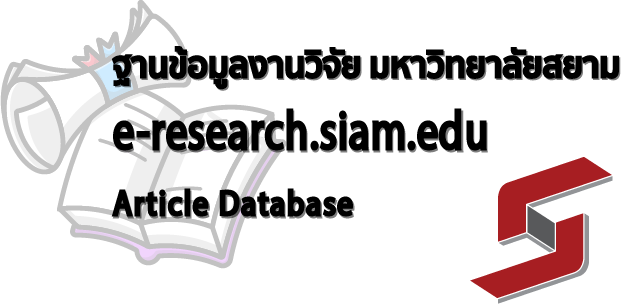- KB Home
- -ประเภทของโครงการ | Project Type
- บทความวิชาการ | Academic Article
- TCI
- Prevalence and Factors Associated with Work-Related Musculoskeletal Disorder among Central Sterile Supply Technicians in Nakhon Si Thammarat Province, Thailand
| Title: | Prevalence and Factors Associated with Work-Related Musculoskeletal Disorder among Central Sterile Supply Technicians in Nakhon Si Thammarat Province, Thailand |
| Researcher: | Withaya Chanchai, Ratree Nacglud, Keatkongkrai Bunnum, Nureeya Promsorn, Laddawan Duangmusik, Warunee Suwanrauthors, Wichuda Chantasin and Kritsana Thonnan |
| Degree: | Bachelor of Science Program in Occupational Health and Safety |
| Major: | B.Sc. (Occupational Health and Safety) |
| Faculty of study: | Department of Occupational Health and Safety, Faculty of Medicine |
| Academic year: | 2567 (2024) |
| Published: | Chulalongkorn Medical Journal: Vol. 68: Iss. 4, Article 3. pp.251 – 259 DOI: https://doi.org/10.56808/2673-060X.5398 Click |
Abstract
Background: Central Sterile Supply Technicians (CSSTs) face an elevated risk of work-related musculoskeletal disorders (WMSDs), notably affecting the back.
Objective: This study aimed to examine the prevalence and factors associated with work-related musculoskeletal disorders among CSSTs in Nakhon Si Thammarat Province, Thailand.
Methods: A cross-sectional study in Nakhon Si Thammarat, Thailand, assessed WMSDs among CSSTs using self-administered questionnaires on demographics and symptoms. Out of 188 distributed, 179 were completed, evaluating disorder presence and severity during sterilization in 33 hospitals.
Results: The prevalence rate of work-related musculoskeletal disorders (WMSDs) in various body regions, particularly the upper back, at the time of questioning (88.2%), during the past week (79.3%), and over the past year (77.7%). Technicians with over 30 years of experience showed a significantly higher risk of musculoskeletal disorders (OR 8.71, 95% CI 1.44 – 6.29). CSSTs with over ten years of employment showed significant associations (OR 7.86, 95% CI 1.30 – 5.01). Other factors included working day shifts (OR 19.17, 95% CI 10.22 – 120.46), heavy load handling (OR 20.01, 95% CI 10.76 – 153.55), lifting of instruments (OR 2.01, 95% CI 1.40 – 5.52), transporting equipment or carts (OR 2.99, 95% CI 1.89 – 7.27), pushing equipment or carts (OR 9.19, 95% CI 1.40 – 5.52), carrying instruments (OR 5.58, 95% CI 1.13 – 4.27), and uncomfortable postures (OR 7.65, 95% CI 1.38 – 7.57).
Conclusion: These findings highlight the high prevalence of work-related musculoskeletal disorders among CSSTs, particularly impacting the upper back. Factors such as prolonged employment and physically demanding tasks significantly contribute to these disorders.
Keywords: Central sterile supply technicians, musculoskeletal disorders, risk factors.
ดร.วิทยา ชาญชัย – Dr. Withaya Chanchai. 2567 (2024). Prevalence and Factors Associated with Work-Related Musculoskeletal Disorder among Central Sterile Supply Technicians in Nakhon Si Thammarat Province, Thailand. บทความ (Paper). Advisor: วิทยาศาสตร์สุขภาพ|Health Science. แพทยศาสตร์ ภาควิชาสาธารณสุขศาสตร์ (Medicine, Department of Public Health Science). วิทยาศาสตรบัณฑิต สาขาวิชาอาชีวอนามัยและความปลอดภัย – Bachelor of Science Program in Occupational Health and Safety. วท.บ. (สาขาวิชาอาชีวอนามัยและความปลอดภัย) – B.Sc. (Occupational Health and Safety). Bangkok: Siam University


